
Transport in Belgium is facilitated with well-developed road, air, rail and water networks. The rail network has 2,950 km (1,830 mi) of electrified tracks. There are 118,414 km (73,579 mi) of roads, among which there are 1,747 km (1,086 mi) of motorways, 13,892 km (8,632 mi) of main roads and 102,775 km (63,861 mi) of other paved roads. There is also a well-developed urban rail network in Brussels, Antwerp, Ghent and Charleroi. The ports of Antwerp and Bruges-Zeebrugge are two of the biggest seaports in Europe. Brussels Airport is Belgium's biggest airport.

Charleroi is a city and a municipality of Wallonia, located in the province of Hainaut, Belgium. The city is situated in the valley of the Sambre, in the south-west of Belgium, not far from the border with France. By 1 January 2008, the total population of Charleroi was 201,593. The metropolitan area, including the outer commuter zone, covers an area of 1,462 square kilometres (564 sq mi) with a total population of 522,522 by 1 January 2008, ranking it as the 5th most populous in Belgium after Brussels, Antwerp, Liège, and Ghent. The inhabitants are called Carolorégiens or simply Carolos.

Thuin is a city and municipality of Wallonia located in the province of Hainaut, Belgium.

The interurban is a type of electric railway, with tram-like electric self-propelled rail cars which run within and between cities or towns. The term "interurban" is usually used in North America, with other terms used outside it. They were very prevalent in North America between 1900 and 1925 and were used primarily for passenger travel between cities and their surrounding suburban and rural communities. The concept spread to countries such as Japan, the Netherlands, Switzerland, Belgium, Italy and Poland. Interurban as a term encompassed the companies, their infrastructure, their cars that ran on the rails, and their service. In the United States, the early 1900s interurban was a valuable economic institution, when most roads between towns, many town streets were unpaved, and transportation and haulage was by horse-drawn carriages and carts.
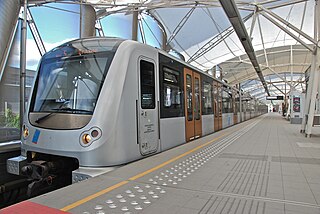
The Brussels Metro is a rapid transit system serving a large part of the Brussels-Capital Region of Belgium. It consists of four conventional metro lines and three premetro lines. The metro-grade lines are M1, M2, M5, and M6 with some shared sections, covering a total of 39.9 kilometres (24.8 mi), with 59 metro-only stations. The premetro network consists of three tram lines that partly travel over underground sections that were intended to be eventually converted into metro lines. Underground stations in the premetro network use the same design as metro stations. A few short underground tramway sections exist, so there is a total of 52.0 kilometres (32.3 mi) of underground metro and tram network. There are a total of 69 metro and premetro stations as of 2011.
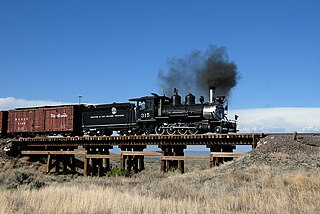
Conservation and restoration of rail vehicles aims to preserve historic rail vehicles.
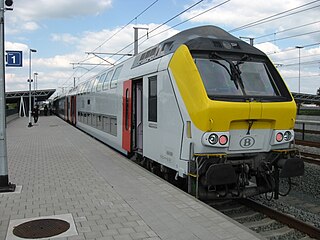
Belgium has an extensive rail network. It is a member of the International Union of Railways (UIC). The UIC Country Code for Belgium is 88.

Heritage streetcars or heritage trams are a part of the efforts to preserve rail transit heritage. In addition to preserving street-running rail vehicles, heritage streetcar operations can include upkeep of historic rail infrastructure. Working heritage streetcars are closely related to the growing global heritage railway movement and form a part of the living history of rail transport.

The National Company of Light Railways was a state-owned transportation provider which comprised a system of narrow-gauge tramways or local railways in Belgium, which covered the whole country, including the countryside, and had a greater route length than the mainline railway system. They were 1,000 mmmetre gauge and included electrified city lines and rural lines using steam locomotives and diesel railcars; half the system was electrified.

The Brussels tramway network is a tram system serving a large part of the Brussels-Capital Region of Belgium. It is the 16th largest tram system in the world by route length, in 2017 providing 149.1 million journeys over routes 140.6 km (87.4 mi) in length. In 2018, it consisted of 18 tram lines. Brussels trams are operated by STIB/MIVB, the local public transport company.
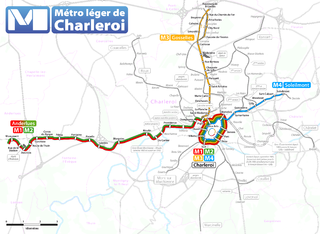
The Métro Léger de Charleroi is a 33-kilometre (21 mi) light rail network in Belgium. The system consists of a loop line around central Charleroi and three branches towards the suburbs of Gilly, Anderlues and Gosselies. Another branch to Châtelet was partially built, never entered service, but will finally do so in 2026.

The Tramway touristique de l'Aisne is the official designation of the tourist use of a former rural vicinal tramway in Belgium.

The Antwerp tramway network is a network of tramways forming part of the public transport system in Antwerp, a city in the Flemish Region of Belgium. The network is operated by the Flemish region's transportation company De Lijn. As of April 2017, it featured fourteen lines, eight of which pass partially underground.
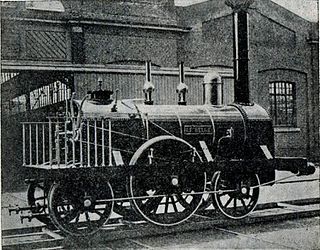
Belgium was heavily involved in the early development of railway transport. Belgium was the second country in Europe, after Great Britain, to open a railway and produce locomotives. The first line, between the cities of Brussels and Mechelen opened in 1835. Belgium was the first state in Europe to create a national railway network and the first to possess a nationalised railway system. The network expanded fast as Belgium industrialised, and by the early 20th century was increasingly under state-control. The nationalised railways, under the umbrella organisation National Railway Company of Belgium (NMBS/SNCB), retained their monopoly until liberalisation in the 2000s.
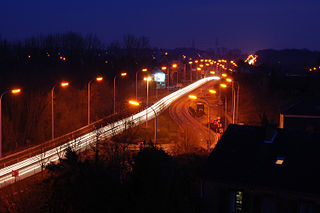
Schepdaal is a village and deelgemeente of Dilbeek in Flanders, Belgium.
Line M1 is a line of the Charleroi Metro in Belgium operated by TEC Charleroi, running from the Monument tram stop in Anderlues to the metro loop around central Charleroi, before heading back to Anderlues. Line M1 was created on 27 February 2012 to replace former lines 88 and 89 after completion of the loop around central Charleroi. Introduction of new line numbers in February 2012 coincided with the formal association of colors to line numbers. The official color for line M1 is red.

Line M2 is a line of the Charleroi Metro in Belgium operated by TEC Charleroi, running from the Monument tram stop in Anderlues to the metro loop around central Charleroi, before heading back to Anderlues. Line M2 was created on 27 February 2012 to replace former lines 88 and 89 after completion of the loop around central Charleroi. Introduction of new line numbers in February 2012 coincided with the formal association of colors to line numbers. The official color for line M2 is green.
Europe inherited a diversity of rail gauges. Extensive narrow-gauge railway networks exist in Spain, Central Europe and Southeastern Europe.

The Battle of Grand-Reng or Battle of Rouvroi saw a Republican French army jointly commanded by Louis Charbonnier and Jacques Desjardin attempt to advance across the Sambre River against a combined Habsburg Austrian and Dutch army under Franz Wenzel, Graf von Kaunitz-Rietberg. After winning crossings over the Sambre at Thuin and Lobbes on the 10th and Merbes-le-Château on the 12th, the French were defeated on 13 May at Grand-Reng and forced to retreat. The War of the First Coalition engagement marked the first of five attempts by the French armies to establish themselves on the north bank of the Sambre. Grand-Reng is now part of the village of Erquelinnes, Belgium, lying close to the border with France. Rouveroy (Rouvroi) is situated 3.8 kilometres (2.4 mi) north. Grand-Reng is located about 33 kilometres (21 mi) southwest of Charleroi.
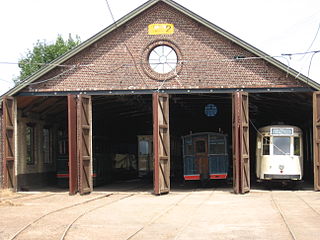
The Tramsite Schepdaal is a tramway museum in Schepdaal, located in the Belgian municipality Dilbeek, west of Brussels





























